肯定句及祈使句变否定句
- 格式:doc
- 大小:43.50 KB
- 文档页数:5
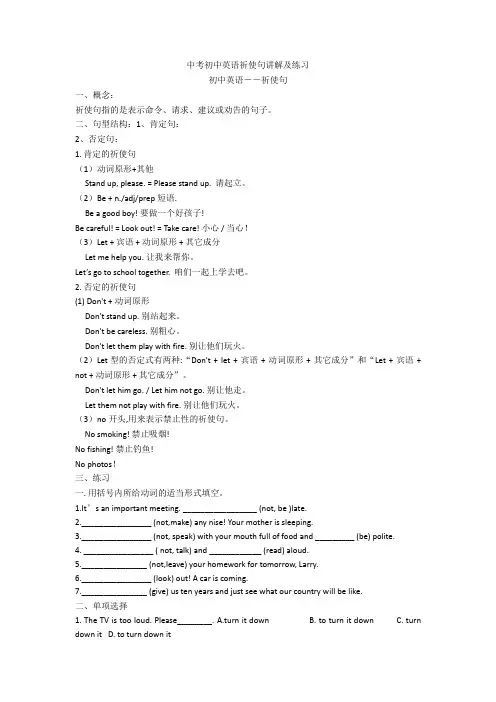
中考初中英语祈使句讲解及练习初中英语――祈使句一、概念:祈使句指的是表示命令、请求、建议或劝告的句子。
二、句型结构:1、肯定句:2、否定句:1. 肯定的祈使句(1)动词原形+其他Stand up, please. = Please stand up. 请起立。
(2)Be + n./adj/prep短语.Be a good boy! 要做一个好孩子!Be careful! = Look out! = Take care! 小心 / 当心!(3)Let + 宾语 + 动词原形 + 其它成分Let me help you. 让我来帮你。
Let’s go to school together. 咱们一起上学去吧。
2. 否定的祈使句(1) Don't + 动词原形Don't stand up. 别站起来。
Don't be careless. 别粗心。
Don't let them play with fire. 别让他们玩火。
(2)Let型的否定式有两种:“Don't + let + 宾语 + 动词原形 + 其它成分”和“Let + 宾语 + not + 动词原形 + 其它成分”。
Don't let him go. / Let him not go. 别让他走。
Let them not play with fire. 别让他们玩火。
(3)no开头,用来表示禁止性的祈使句。
No smoking! 禁止吸烟!No fishing! 禁止钓鱼!No photos!三、练习一. 用括号内所给动词的适当形式填空。
1.It’s an important meeting. _________________ (not, be )late.2.________________ (not,make) any nise! Your mother is sleeping.3.________________ (not, speak) with your mouth full of food and _________ (be) polite.4. ________________ ( not, talk) and ____________ (read) aloud.5._______________ (not,leave) your homework for tomorrow, Larry.6.________________ (look) out! A car is coming.7._______________ (give) us ten years and just see what our country will be like.二、单项选择1. The TV is too loud. Please________. A.turn it down B. to turn it down C. turn down it D. to turn down it2. _______ late again, Bill!A. Don't to beB. Don't beC. Not beD. Be not3. _______ cross the road until the traffic lights turn green.A. NotB. Won'tC. Doesn'tD. Don't4. Please help me carry it, ______?A. will IB. will youC. shall ID. shall we5. Don't make so much noise, ______?A. will youB. won't youC. shall weD. do you6. Do you know the girl ______under the tree?A. standB. to standC. standingD. stood7. Kate, _______ your homework here tomorrow.A. bringB. bringsC. to bringD. bringing8. ________ me the truth, or I'll be angry.A. TellingB. To tellC. ToldD. Tell9. I've kept the dog _______Maomao for a long time.A. NameB. namedC. namingD. to name10. Don't you know that _______ is good for our health?A. swimB. swimmingC. swamD. swims11 .Her doctor said: “________ work so hard”A StopB Don’tC Can’tD No14. ________him the secret, will you?A Don’t tellB Not to tellC Not tellingD No telling15. ________ in bed. It’s bad for your eyes.A Not to readB Don’t readC Don’t to readD Not read16. ________ Your child. We’ll look after him.A Not to worry aboutB Don’t worry aboutC Not worry forD Don’t worry with20.Please ________ look outside. Look at the blackboard.A notB don’tC aren’tD can’t三、句型转换1. Will you please read it again more slowly? (改为祈使句)_______ ________ again more slowly, please.2. If you don't listen to me, I'll go. (改为同义句)________ ________me, or I’ll go.4. The teachers often tell the students not to be careless. (改为祈使句)_______ _______careless, please.5. Please sit next to Nancy. (改为否定句)_______ _______ next to Nancy.6. Don't forget to turn off the lights, please. (改为反意疑问句)Don't forget to turn off the lights, _______ _______?7. If you move, you'll die. (改为同义句)_______ ______, or you'll die.二、英语书面表达专项训练2.朋友是我们生活的组成部分,他们总是在我们最需要帮助的时候陪伴我们。

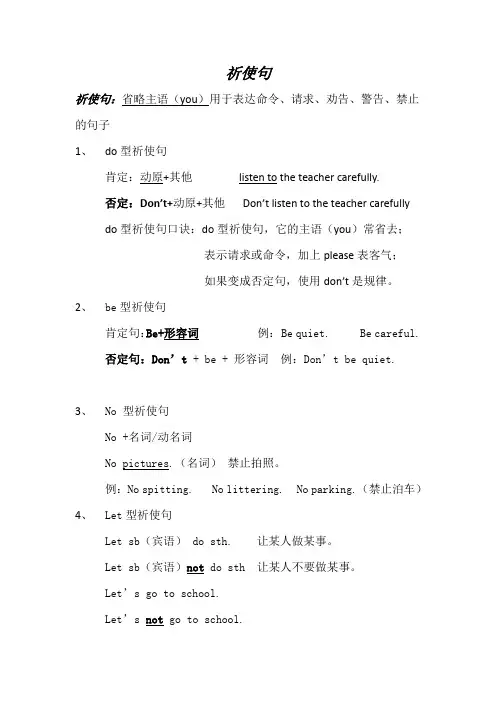
祈使句
祈使句:省略主语(you)用于表达命令、请求、劝告、警告、禁止的句子
1、do型祈使句
肯定:动原+其他listen to the teacher carefully.
否定:Don’t+动原+其他Don’t listen to the teacher carefully
do型祈使句口诀:do型祈使句,它的主语(you)常省去;
表示请求或命令,加上please表客气;
如果变成否定句,使用don’t是规律。
2、be型祈使句
肯定句:Be+形容词例: Be quiet. Be careful.
否定句:Don’t + be + 形容词例:Don’t be quiet.
3、No 型祈使句
No +名词/动名词
No pictures.(名词)禁止拍照。
例:No spitting. No littering. No parking.(禁止泊车)4、Let型祈使句
Let sb(宾语) do sth. 让某人做某事。
Let sb(宾语)not do sth 让某人不要做某事。
Let’s go to school.
Let’s not go to school.。
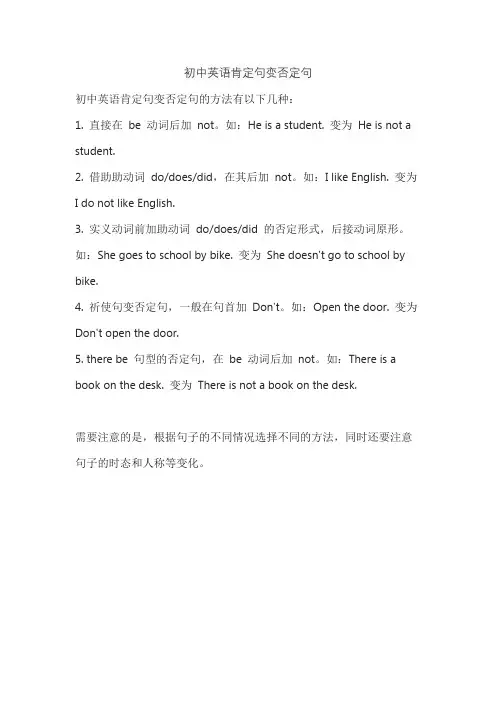
初中英语肯定句变否定句
初中英语肯定句变否定句的方法有以下几种:
1. 直接在be 动词后加not。
如:He is a student. 变为He is not a student.
2. 借助助动词do/does/did,在其后加not。
如:I like English. 变为
I do not like English.
3. 实义动词前加助动词do/does/did 的否定形式,后接动词原形。
如:She goes to school by bike. 变为She doesn't go to school by bike.
4. 祈使句变否定句,一般在句首加Don't。
如:Open the door. 变为Don't open the door.
5. there be 句型的否定句,在be 动词后加not。
如:There is a book on the desk. 变为There is not a book on the desk.
需要注意的是,根据句子的不同情况选择不同的方法,同时还要注意句子的时态和人称等变化。

肯定句变否定句的基本方法一、动词be 的否定式动词be根据不同的人称和时态可以有am, is, are, was, were等不同形式,可用作连系动词(表示“是”、“在”等)和助动词(用于构成进行时态和被动语态等),但不管何种情况,构成否定式时,一律在其后加notI’m old, but you’re young. 我老了,但你还年轻。
→I’m not old, but you’re not young. 我还不老,但你不年轻了。
He was reading and I was writing. 他在读,我在写。
→He was not reading and I was not writing. 他没有在读,我没有在写。
二、动词have 的否定式动词have根据不同的人称和时态可以有have, has, had等形式,可以用作实意动词和助动词,分以下情况讨论1. 用作实意动词表示状态,如表示拥有、患病或用于have to表示“必须”等,在构成否定式时可以直接在其后加not,也可根据情况在其前使用don’t, doesn’t, didn’tHe has a car. 他有辆小汽车。
→He hasn’t a car. / He doesn’t have a car. 他没有小汽车。
He had some dictionaries. 他有一些词典。
→He hadn’t any dictionaries. / He didn’t have any dictionaries. 他没有词典。
You have to go with him. 你必须同他一起去。
→You haven’t to go with him. / You don’t have to go w ith him. 你不必同他一起去。
【注】have to构成否定式时以在其前加don’t等较为常见。
2. 用作实意动词表示动作,如表示“吃(=eat)”、“喝(=drink)”、“拿(=take)”、“收到(=receive)”、“度过(=spend)”等,构成否定式时不能直接在其后加not,而应根据情况在其前使用don’t, doesn’t, didn’tHe had some cake for breakfast. 他早餐吃了些蛋糕。
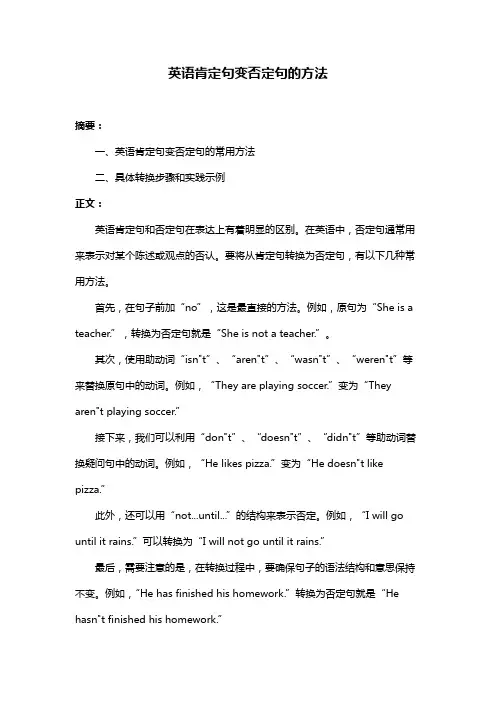
英语肯定句变否定句的方法摘要:一、英语肯定句变否定句的常用方法二、具体转换步骤和实践示例正文:英语肯定句和否定句在表达上有着明显的区别。
在英语中,否定句通常用来表示对某个陈述或观点的否认。
要将从肯定句转换为否定句,有以下几种常用方法。
首先,在句子前加“no”,这是最直接的方法。
例如,原句为“She is a teacher.”,转换为否定句就是“She is not a teacher.”。
其次,使用助动词“isn"t”、“aren"t”、“wasn"t”、“weren"t”等来替换原句中的动词。
例如,“They are playing soccer.”变为“They aren"t playing soccer.”接下来,我们可以利用“don"t”、“doesn"t”、“didn"t”等助动词替换疑问句中的动词。
例如,“He likes pizza.”变为“He doesn"t like pizza.”此外,还可以用“not...until...”的结构来表示否定。
例如,“I will go until it rains.”可以转换为“I will not go until it rains.”最后,需要注意的是,在转换过程中,要确保句子的语法结构和意思保持不变。
例如,“He has finished his homework.”转换为否定句就是“He hasn"t finished his homework.”总之,掌握以上方法,就可以轻松地将英语肯定句转换为否定句。
在实际应用中,根据不同的语境和句子结构,选择合适的方法进行转换,使句子更加丰富和生动。
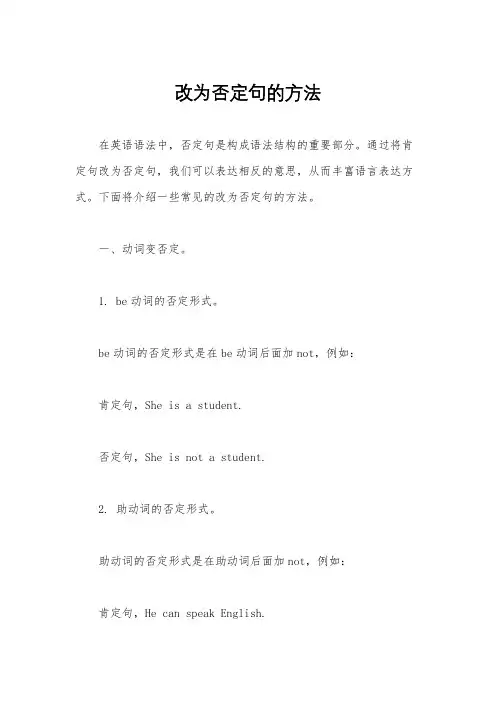
改为否定句的方法在英语语法中,否定句是构成语法结构的重要部分。
通过将肯定句改为否定句,我们可以表达相反的意思,从而丰富语言表达方式。
下面将介绍一些常见的改为否定句的方法。
一、动词变否定。
1. be动词的否定形式。
be动词的否定形式是在be动词后面加not,例如:肯定句,She is a student.否定句,She is not a student.2. 助动词的否定形式。
助动词的否定形式是在助动词后面加not,例如:肯定句,He can speak English.否定句,He cannot speak English.3. 一般动词的否定形式。
一般动词的否定形式是在动词前面加do not或does not,例如:肯定句,They like playing basketball.否定句,They do not like playing basketball.二、副词的否定形式。
有些副词的否定形式是在词前加not,例如:肯定句,She usually goes to work by bus.否定句,She does not usually go to work by bus.三、形容词的否定形式。
形容词的否定形式是在词前加not,例如:肯定句,The movie is interesting.否定句,The movie is not interesting. 四、名词的否定形式。
名词的否定形式是在名词前加no,例如:肯定句,There is a book on the table.否定句,There is no book on the table. 五、句子的否定形式。
句子的否定形式是在句子前面加否定词,例如:肯定句,She will come to the party.否定句,She will not come to the party.六、疑问句的否定形式。
疑问句的否定形式是在疑问句前面加否定词,例如:肯定句,You have finished your homework.否定句,Have you not finished your homework?七、祈使句的否定形式。
![[精品]把肯定句改成否定句](https://uimg.taocdn.com/0cb8e8bcaff8941ea76e58fafab069dc51224752.webp)
[精品]把肯定句改成否定句一、首先,要看肯定句中是否有情态动词,如果有情态动词,直接在情态动词后面加not即可,同时句中如果有some,some就要变成any。
举例如下:1、肯定句:Mike can help you solve the problem.译文:迈克可以帮你解决那个问题。
否定句:Mike can't help you solve the problem. (can't=can not)译文:迈克不能帮你解决那个问题。
2、肯定句:You should lend some money to Mary.译文:你应该借给玛丽一些钱。
否定句:You shouldn't lend any money to Mary. (shouldn't=should not)译文:你不应该借钱给玛丽。
二、如果肯定句中没有情态动词,那就要看句中有无be动词的相应形式,如果有,直接在be动词后面加not,句中有some,some变any。
举例如下:1、肯定句:I am an English teacher.译文:我是一名英语老师。
否定句:I‘m not an English teacher.译文:我不是一名英语老师。
2、肯定句:There are some books on the desk.译文:书桌上有一些书。
否定句:There aren't any books on the desk.译文:书桌上没有书。
三、如果肯定句中既没有情态动词,也没有be动词,那么就要用相应的助动词加上not来变换,句中有some,some变any。
举例如下:1、肯定句:She likes helping others.译文:她喜欢帮助别人。
否定句:She doesn't like helping others.译文:她不喜欢帮助别人。
2、肯定句:They have some apples.译文:他们有一些苹果。
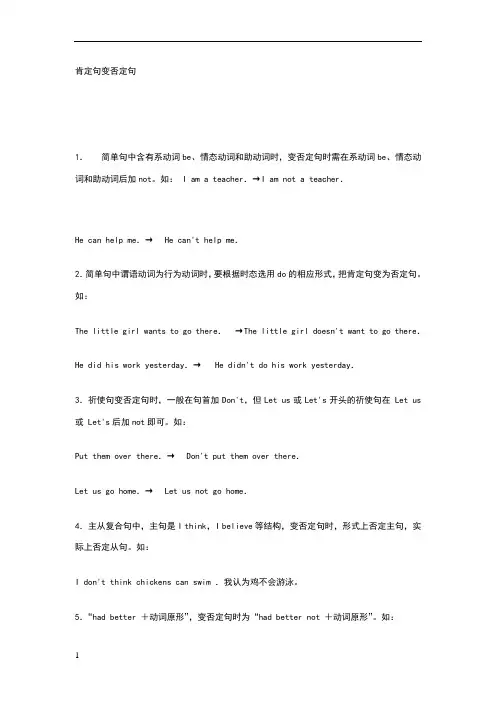
肯定句变否定句1.简单句中含有系动词be、情态动词和助动词时,变否定句时需在系动词be、情态动词和助动词后加not。
如: I am a teacher.→I am not a teacher.He can help me.→He can't help me.2.简单句中谓语动词为行为动词时,要根据时态选用do的相应形式,把肯定句变为否定句。
如:The little girl wants to go there.→The little girl doesn't want to go there.He did his work yesterday.→ He didn't do his work yesterday.3.祈使句变否定句时,一般在句首加Don't,但Let us或Let's开头的祈使句在 Let us 或 Let's后加not即可。
如:Put them over there.→Don't put them over there.Let us go home.→Let us not go home.4.主从复合句中,主句是I think,I believe等结构,变否定句时,形式上否定主句,实际上否定从句。
如:I don't think chickens can swim .我认为鸡不会游泳。
5.“had better +动词原形”,变否定句时为“had better not +动词原形”。
如:You'd better go to school.→ You'd better not go to school.6.动词不定式变否定式时,常在不定式to前加not。
如:The teacher tells me to do it.→ The teacher tells me not to do it.7.使役动词和感官动词(make,let,hear,see,watch等)后接省略to的不定式,此种不定式变否定句时只需在省略to的动词原形前加not。

一、简单句中含有be动词、情态动词和助动词时,变否定句时需在be动词、情态动词和助动词后加not。
1. (am, is ,are 是be动词)如:I am a teacher.→I am nota teacher.This is a pen.→ This is not a pen.或This isn’t a pen. (is not =isn’t) You are a boy. →You are not a boy. (are not =aren’t)2. (can是情态动词)He can help me.→He can not help me.或He can’t help me.(can not =can’t )3.当主语是第一人称、第二人称和第三人称复数时用助动词do,变否定时,在do后面加not 如:I like English .I do not like English.或I don’t like English.They go to school together. →They do not (don’t) go to school together.4.当主语是第三人称单数时用does,变否定时,在does后面加not,如:The little girl wants to go there.→ The little girl does not (doesn't ) want to go there.2.简单句中谓语动词为行为动词时,要根据时态选用do的相应形式,把肯定句变为否定句。
如:The little girl wants to go there.→The little girl doesn't want to go there.He did his work yesterday.→He didn't do his work yesterday.3.祈使句变否定句时,一般在句首加Don't,但Let us或Let's 开头的祈使句在Let us或Let's后加not也可。
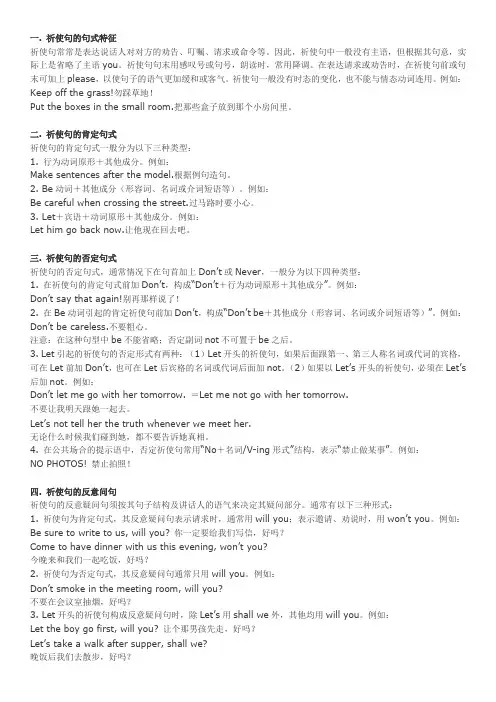
一. 祈使句的句式特征祈使句常常是表达说话人对对方的劝告、叮嘱、请求或命令等。
因此,祈使句中一般没有主语,但根据其句意,实际上是省略了主语you。
祈使句句末用感叹号或句号,朗读时,常用降调。
在表达请求或劝告时,在祈使句前或句末可加上please,以使句子的语气更加缓和或客气。
祈使句一般没有时态的变化,也不能与情态动词连用。
例如:Keep off the grass!勿踩草地!Put the boxes in the small room.把那些盒子放到那个小房间里。
二. 祈使句的肯定句式祈使句的肯定句式一般分为以下三种类型:1. 行为动词原形+其他成分。
例如:Make sentences after the model.根据例句造句。
2. Be动词+其他成分(形容词、名词或介词短语等)。
例如:Be careful when crossing the street.过马路时要小心。
3. Let+宾语+动词原形+其他成分。
例如:Let him go back now.让他现在回去吧。
三. 祈使句的否定句式祈使句的否定句式,通常情况下在句首加上Don’t或Never,一般分为以下四种类型:1. 在祈使句的肯定句式前加Don’t,构成“Don’t+行为动词原形+其他成分”。
例如:Don’t say that again!别再那样说了!2. 在Be动词引起的肯定祈使句前加Don’t,构成“Don’t be+其他成分(形容词、名词或介词短语等)”。
例如:Don’t be careless.不要粗心。
注意:在这种句型中be不能省略;否定副词not不可置于be之后。
3. Let引起的祈使句的否定形式有两种:(1)Let开头的祈使句,如果后面跟第一、第三人称名词或代词的宾格,可在Let前加Don’t,也可在Let后宾格的名词或代词后面加not。
(2)如果以Let’s开头的祈使句,必须在Let’s 后加not。
例如:Don’t let me go with her tomorrow. =Let me not go with her tomorrow.不要让我明天跟她一起去。
肯定句否定句与祈使句的句式变化肯定句、否定句与祈使句的句式变化在英语语法中,肯定句、否定句和祈使句是常见的句式形式。
不同的句式可以通过特定的结构和词语进行变化,以表达不同的意思和语气。
本文将介绍肯定句、否定句和祈使句的句式变化方式。
一、肯定句(Affirmative Sentences)肯定句是表达肯定或陈述的句子形式。
一般来说,肯定句的基本结构是主语 + 谓语 + 宾语(如果有的话)。
在肯定句中,常出现一些修饰词语,如副词、形容词等,用来进一步描述主语或谓语。
下面是一些肯定句的例子:1. She is reading a book.2. They have visited Japan.3. I like chocolate.二、否定句(Negative Sentences)否定句是用来否定陈述或表达反对意见的句子形式。
否定句通常在动词前加上否定词(如not),或者使用带有否定意义的词语来改变原始句子的意思。
以下是否定句的几种常见形式:1. She is not reading a book.2. They have not visited Japan.3. I do not like chocolate.需要注意的是,对于助动词的否定形式,通常在助动词后面添加not。
例如:He can swim.(他会游泳。
)He cannot swim.(他不会游泳。
)三、祈使句(Imperative Sentences)祈使句是用来表达请求、命令或建议等意愿的句子形式。
祈使句常用来表示一种建议、要求或命令,而且主语通常省略,所以祈使句的基本结构就是谓语动词本身。
以下是一些祈使句的例子:1. Open the window, please.(请打开窗户。
)2. Don't be late for the meeting.(不要迟到会议。
)3. Be careful!(小心点!)需要注意的是,祈使句的谓语动词通常是原形(原始形式),表示祈使或命令的语气。
祈使句肯定句和否定句的结构1. 咱在岗位上就得像老黄牛一样,勤勤恳恳,你看王师傅,每天最早到岗,最晚离岗,这就是尽职尽责啊!例子:“嘿,你们看王师傅,那真是没话说,每天都来得那么早,把车间打扫得干干净净,设备检查得仔仔细细,这不是尽职尽责是什么呀?”2. 你要是在岗位上不尽职尽责,那怎么能行呢?就像小李,对工作那叫一个上心,从不出错!例子:“哎呀,小李对待工作那认真劲儿,真让人佩服!每次任务都完成得那么出色,他可真是做到了尽职尽责呀!”3. 岗位上尽职尽责不就是应该的嘛,这就好比是战士守卫边疆一样,责无旁贷呀!小赵就是这样的典范。
例子:“你们说小赵多棒啊,不管多苦多累的活,都毫无怨言地干,这和战士守卫边疆有啥区别,这就是尽职尽责呀!”4. 一个人在岗位上不尽职尽责,那还不如回家睡大觉呢!就像老孙,那可是大家学习的榜样。
例子:“哇塞,老孙工作起来那股劲儿,谁能比呀!把每一件事都做得那么完美,这就是在岗位上尽职尽责啊!”5. 难道在岗位上尽职尽责很难吗?看看人家小张,总是能把工作安排得妥妥当当。
例子:“哟呵,小张可真厉害,各种任务在他手里都变得轻松简单了,他这就是在岗位上尽职尽责呀!”6. 只有在岗位上尽职尽责,才能真正体现自己的价值啊,就像刘姐,那可是出了名的负责。
例子:“你们知道刘姐吧,她对工作的态度那真是没得说,从来都是一丝不苟,这就是尽职尽责的表现呀!”7. 在岗位上不尽职尽责,那不是在混日子嘛!瞧瞧人家小王,那才叫一个靠谱。
例子:“嘿,小王干活多实在呀,每一个细节都不放过,这就是对岗位尽职尽责呀!”8. 你说不在岗位上尽职尽责能行么?就像老周,多少年如一日地坚守岗位。
例子:“哎呀呀,老周真是不容易呀,这么多年一直坚守在自己的岗位上,认真负责,这就是尽职尽责啊!”9. 岗位上尽职尽责就是要全力以赴呀,像小吴这样,总是充满激情。
例子:“哇,小吴工作的时候就像打了鸡血一样,活力满满,这就是在岗位上尽职尽责的样子啊!”10. 不在岗位上尽职尽责,那工作还有啥意义呢?就像老马,默默奉献。
祈使句的肯定句和否定句的例子
嘿,朋友们!让我来给你们讲讲祈使句的肯定句和否定句。
先来说说肯定句吧。
“快来尝尝这个蛋糕呀!”瞧,当妈妈做好了美味的蛋糕,兴高采烈地对我喊出这句话时,我那迫不及待的心情瞬间就被点燃了,飞奔过去大快朵颐。
这种肯定的祈使,带着满心的期待和欢喜,让人没办法拒绝呀。
再比如,“一起去看电影吧!”当朋友满脸兴奋地说出这句话时,我的心也跟着雀跃起来,仿佛已经置身在电影院里享受精彩的剧情了。
这就是肯定祈使句的魅力呀,充满了邀请和热情!
接着讲讲否定句哦。
“别跑那么急,小心摔着!”这句话是不是特别熟悉?就像妈妈总是担心我们,急切地喊出这句话来提醒我们。
这里面既有对我们的关心,又带着那么一点“命令”的味道,但却是充满爱意的呀。
还有啊,“别熬夜,对身体不好!”当关心你的人皱着眉头说出这句话时,你就能感受到那种担忧和希望你照顾好自己的心情。
虽然是否定的表达,但满满都是爱呢!
祈使句啊,就像是生活中的调味剂,让我们的交流更加丰富生动。
肯定句就像阳光,温暖而热烈;否定句则像微风,轻轻提醒着我们。
它们在我们的生活中无处不在,无论是家人之间的关切,朋友之间的邀约,还是陌生人之间简单的指示,都有着祈使句的身影。
无论是肯定还是否定,都是为了让我们的生活更加美好呀,难道不是吗?所以,我们要好好珍惜这些或热情或关心的话语,让它们成为我们生活中温暖的力量呀!
我的观点就是:祈使句虽小,作用却大,它们让我们的情感和交流更加多姿多彩!。
英语句型转换之一——肯定句变否定句的技巧请同学们记住以下单词:1、be动词的五种形式:am, is, are, was, were;2、情态动词:can, could, may, might, must, shall, should,will,would, need, had better3、助动词:have, has, had一、动词后直接加not原句中含有be动词(am, is, are, was, were) 和情态动词(can, shall, will, may, should, would, might, had better等)时,要在动词后直接加not。
如:1. I am a teacher. → I am not a teacher.2. Li Lei can swim. → Li Lei cannot( can't )swim.3. He will go to the zoo if it rains tomorrow.→ He will not(won't)go to the zoo if it rains tomorrow.4. We have learned 3,000 words.→ We have not( haven't )learned 3,000 words.二、原句中没有be动词,助动词或情态动词时,要在行为动词前加助动词(do, does, did)与否定副词not的缩写形式。
1. 句中第一个动词是原形时,在其前加上don’t。
如:I get up at six o'clock every day.→ I don't get up at six o'clock every day.2. 句中第一个动词是三单形式时,在其前加上doesn’t,原来的动词三单形式改为动词原形。
如:Mr Wang works in a factory.→ Mr Wang doesn't work in a factory.3. 句中第一个动词是过去式时,在其前加上didn’t,原来的动词过去式改为动词原形。
如何将肯定句改为否定句方法一谓语动词是be、have(作“有”讲) ,或谓语动词有助动词、情态动词时,在它们的后面加not。
若句中有some时,需将some改为any。
例如:I have some books on this subject.→I have not any books on this subject.He can speak English.→He cannot speak English.方法二当谓语动词是行为动词时,而句中又没有情态动词或助动词时,需要在谓语动词之前加do not (或did not) 来构成否定句。
例如:I know something about it.→ I don’t know anything about it.方法三否定由think、believe、know等动词引出的宾语从句时,应将主句改为否定形式。
例如:She knows why the train is late.→She doesn’t know why the train is late.方法四祈使句的否定形式是在谓语动词前直接加do not。
例如:Read in bed.→Don’t read in bed.方法五如果肯定句是特殊句型,则要具体问题具体分析:陈述句中含有had better时,变为否定句时,要把not加在better后。
例如:You had better go with me.→You had better not go with me.陈述句中含有both (all) of +名词作主语时,改为否定句时,要用neither 来代替both,none代替all。
并注意谓语动词数的变化。
例如:Both of them are Americans.→Neither of them is American.。
中考句型转换错误分析肯定句变否定句
1. I think she is there.
误:I think she isn’t there.
正:I don’t think she is there.
析:英语中think, believe, expect, suppose等表示信念和揣测的动词,后接that从句时,习惯上将从句中的否定形式转移到主句上,即否定主句谓语,不否定从句谓语。
2. He can sing this song and that one.
误:He cannot sing this song and that one.
正;He cannot sing this song or that one.
析:肯定句中的连词and在否定句中一般要改为or。
3. Tom went to school too.
误:Tom didn’t go to school too.
正:Tom didn’t go to school either.
析:too和also用于肯定句中时,否定句中用either替换。
4. He has had supper already.
误:He hasn’t had supper already.
正:He hasn’t had supper yet.
析:随着对谓语动词的否定,某些副词也要作相应的变动。
5. He had a good rest just now.
误:He hadn’t a good rest just now.
正:He didn’t have a good rest just now.
析:have在表示开会、吃饭、休息、进行体育锻炼等词组中是行为动词,否定句用助动词来完成。
6. Let’s do it.
误:Let’s don’t do it.
正:Don’t let’s do it.或Let’s not do it.
析:let后接的是不带to的不定式,变为否定式,直接在句首前加Don’t 或在不定式前加not。
7. He always gets there on time.
误:He doesn’t always get there on time.
正:He never gets there on time.
析:He doe sn’t always get there on time意为“他并非老是准时到那儿”,是部分否定,习惯上把句中的副词改为相应的表示否定的副词即可。
如:
It often rains here. It seldom rains here.
8. Be here early tomorrow.
误:Be not here early tomorrow.
正:Don’t be here early tomorrow.
析:祈使句的否定,一般在谓语动词前加do not的缩写don’t。
9. You had better come.
误:You didn’t have better come.
正:You had better not come.
析:had better相当于一情态动词,不可分割,因此not应放在其后。
would rather也是如此。
10. Both Tom and Xiao Ping went to school.
误:Both Tom and Xiao Ping didn’t go to school.
正:Neither Tom nor Xiao Ping went to school.
析:一个句子中如果有不定代词both,all, every改为否定式时,要把这些不定代词改为相应的表示否定的代词。
中考句型转换错误分析肯定句变否定句
编辑:金子明点击数:1844次录入时间:2008/1/8 14:14:00 我要评论
1. I think she is there.
误:I think she isn’t there.
正:I don’t think she is there.
析:英语中think, believe, expect, suppose等表示信念和揣测的动词,后接that从句时,习惯上将从句中的否定形式转移到主句上,即否定主句谓语,不否定从句谓语。
2. He can sing this song and that one.
误:He cannot sing this song and that one.
正;He cannot sing this song or that one.
析:肯定句中的连词and在否定句中一般要改为or。
3. Tom went to school too.
误:Tom didn’t go to school too.
正:Tom didn’t go to school either.
析:too和also用于肯定句中时,否定句中用either替换。
4. He has had supper already.
误:He hasn’t had supper already.
正:He hasn’t had supper yet.
析:随着对谓语动词的否定,某些副词也要作相应的变动。
5. He had a good rest just now.
误:He hadn’t a good rest just now.
正:He didn’t have a good rest just now.
析:have在表示开会、吃饭、休息、进行体育锻炼等词组中是行为动词,否定句用助动词来完成。
6. Let’s do it.
误:Let’s don’t do it.
正:Don’t let’s do it.或Let’s not do it.
析:let后接的是不带to的不定式,变为否定式,直接在句首前加Don’t或在不定式前加not。
7. He always gets there on time.
误:He doesn’t always get there on time.
正:He never gets there on time.
析:He doesn’t always get there on time意为“他并非老是准时到那儿”,是部分否定,习惯上把句中的副词改为相应的表示否定的副词即可。
如:
It often rains here. It seldom rains here.
8. Be here early tomorrow.
误:Be not here early tomorrow.
正:Don’t be here early tomorrow.
析:祈使句的否定,一般在谓语动词前加do not的缩写don’t。
9. You had better come.
误:You didn’t have better come.
正:You had better not come.
析:had better相当于一情态动词,不可分割,因此not应放在其后。
would rather 也是如此。
10. Both Tom and Xiao Ping went to school.
误:Both Tom and Xiao Ping didn’t go to school.
正:Neither Tom nor Xiao Ping went to school.
析:一个句子中如果有不定代词both,all, every改为否定式时,要把这些不定代词改为相应的表示否定的代词。
祈使句如何变为否定句
一、一般情况
一般说来,祈使句的否定是在祈使句首加Don’t。
如:
(1)Come here. —Don’t come here. 不要来这儿。
(2)Be angry. —Don’t be angry. 不要生气
二、let型
当祈使句表示邀请或建议(Let’s…) 时,则在Let’s与do之间加not。
如:
(1)Let’s talk about it. —Let’s not talk about it. 我们别谈论它吧。
(2)Let’s go swimming there. —Let’s not go swimming there. 我们别去那里游泳吧。
三、无动词型
无动词祈使句的否定:在无动词祈使句的句首加not。
如:
(1)Here? —Not here. 不是这里。
(2)Green?—Not green. 不是绿色的。
(3)This one? —Not this one. 不是这个。